If you ever want someone to realize just how excessive video game magazines were in the mid-1990s, you don’t need to say a thing. Just grab a bloated holiday issue of Electronic Gaming Monthly and wave around all 3,781 pages of it. Then pull out an issue of EGM2 and show the crowd that it wasn’t enough for the magazine to publish just once a month.
EGM2, technically named with an exponent that I don’t care to recreate, doubled Electronic Gaming Monthly’s presence with its premiere issue in July 1994. It retained the layout and features of its parent mag, right down to the letters pages, the wacky What-Ifs column, and the unambitious middle-school reading level. The only thing EGM2 lacked at the time was a reviews section, so readers still needed regular EGM if they wanted to know what editor-in-chief Ed Semrad’s ghost writers and the mysterious Sushi-X thought of Contra Hard Corps or Art of Fighting 2.

Yet EGM2 had slightly different priorities. Semrad’s opening letter explains that EGM2 emphasizes import coverage and arcade-game guides (auguring the publication’s later switch to nothing but strategies). Indeed, the first issue has a robust import section by Nob Ogasawara, who details two freshly announced and rapidly doomed game systems that would never leave Japan: NEC’s PC-FX and Bandai’s Playdia. Of particular note are the aspirations for each console. Bandai envisioned over 200,000 Playdias flying off shelves, and NEC hoped to move half a million PC-FX systems. I hope no executives staked their careers on those numbers.
1. A STREET FIGHTER BACKLASH BEGINS
Street Fighter and Mortal Kombat dominate the issue, of course, with huge previews of Mortal Kombat II and Super Street Fighter II, the latter of which actually uses art from Street Fighter II: The Animated Movie. It’s not all a cheerful parade of hadokens and bicycle kicks, however. You see, the fans are tiring of Street Fighter!
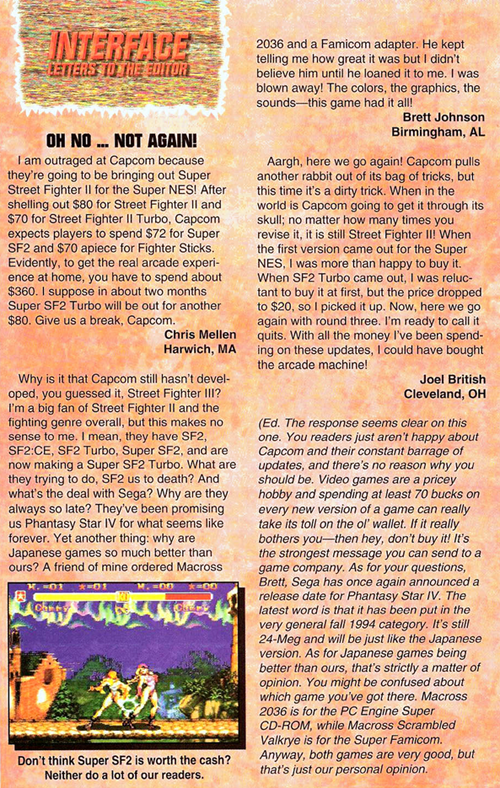
The letters section dedicates a page to readers complaining about Super Street Fighter II, the third iteration of Street Fighter II in as many years. Capcom asked a lot of kids and teenagers in the 1990s: a bunch of us paid over $70 for Street Fighter II in 1992, then $75 for Street Fighter II Turbo in 1993, trading in the older game and soaking up the difference just because Turbo let us play as M. Bison and throw Chun-Li’s fireball. We weren’t going through that again for Super Street Fighter II, not when it offered only four new characters and the only one we cared about was Cammy.
To be fair, some readers are a little off in their math. A Street Fighter II arcade machine cost thousands more than a mere Super NES game in 1994, and good luck beating back the arcade operators who wanted one.
I’ll also admit that Capcom essentially won. Super Street Fighter II wasn’t nearly as successful as its originator, but subsequent games in the series, from the Alphas to Street Fighter V, went through multiple upgrades. And we always buy ‘em.
2. ENVELOPE ART
You can flip through many old game magazines in their entirety, thanks to sites like Retromags. But if you want the era’s zeitgeist at a glance, just look at the reader artwork. It always captures the nerd trends of the day, remixed and combined into chimeral spreads of Sub-Zero killing Barney or Yakko Warner drooling over Blaze from Streets of Rage.
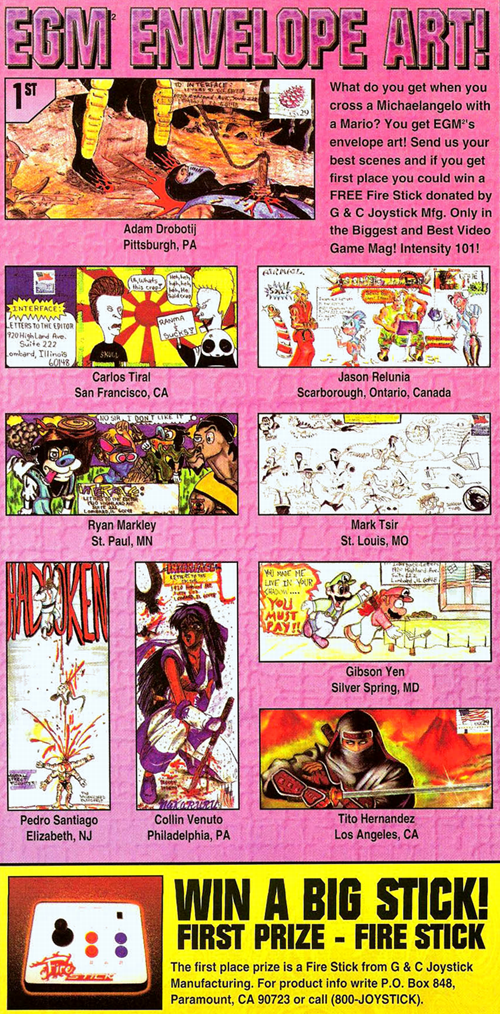
Have a look at EGM2’s first envelope art section, and you’ll see Beavis and Butthead dissing Ranma ½, Sonic giving the Street Fighter II cast hedgehog haircuts, and, of course, a Street Fighter character trouncing a Mortal Kombat character. EGM2 never answers its cover question about which fighting game will come out ahead, but there you have it: Street Fighter is better. So says Pedro Santiago of Elizabeth, New Jersey.
3. MANGA INVADES
An unspoken yet inflexible law commanded every mid-1990s video game magazine to discuss anime and manga. It’s surprising that EGM2’s first issue restricted itself to a corner snippet, considering how often they’d cover the latest Dragon Ball Z fighter or Sailor Moon side-scroller in the years to come.
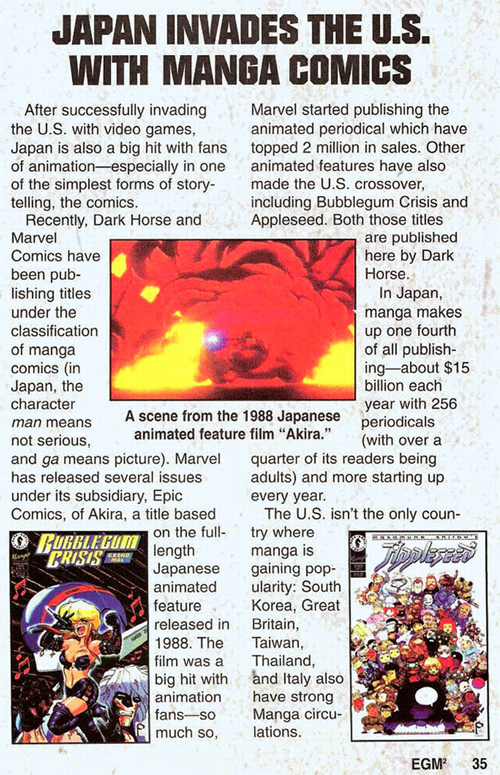
Another law mandated that any mid-1990s story about manga and anime had to take a xenophobic “invasion” angle, with headlines that seemed on the verge of declaring JAPAN BOMBS PEARL HARBOR AGAIN BUT THIS TIME WITH ROBOT COMICS. While EGM2’s piece goes that route for its header, it’s otherwise a short and modestly informative rundown of three anime and manga staples: Akira, Appleseed, and Bubblegum Crisis. Granted, the article assume that the Akira manga was based on the film, and it doesn’t cover the Bubblegum Crisis anime so much as the domestically produced comic by Adam Warren. But arguments over what is or isn’t manga are best left to the second volume of Dramacon.
4. BLOODSTORM RISES EVER SO BRIEFLY
All right, I’ll admit it. I didn’t buy EGM2’s first issue for the latest news from Japan or previews of Breath of Fire or the first screenshots of the Neo Geo CD’s juggling monkey. I bought it for the six-page spread on BloodStorm, a crude and tasteless arcade fighting game that I really, really loved during the summer of 1994 and still do in a strange way.

It was money well spent. BloodStorm has extensive move lists and a surprising depth of secrets; post-victory inputs let you change weapons, warp to other levels, fight hidden characters, and splash insults across the screen. It was as though the game shipped with its debug mode still in effect. I loved it all, from the gory finishing moves to the little catwalk in the background of the sky-pirate stage (where a secret cyborg opponent drops down if you’re nimble enough). Without this massive EGM2 spread, I wouldn’t have known, for example, that Mirage, the desert amazon queen, wields a gauntlet called the “Anigav.” That took me a few days to parse.

Pesina later clarified in interviews that the BloodStorm ad wasn’t an issue; he and Midway were already quits because of a lawsuit he’d filed over Mortal Kombat royalties. Even so, that ad is a wonderful advertising jab. I also agree with it. Heck, I switched to BloodStorm myself for as long as I could find it in arcades!
5. THE MYSTERY OF RED PLASM
The middle chunk of this introductory EGM2 is all about the next lineup of systems: the Saturn, the Neo-Geo CD, the 32X, and an unpretentious little construction called the PlayStation. Two pages detail the system’s initial lineup of games, and it’s interesting to see the humble start for a game-industry juggernaut. Just about every game mentioned made it to market, but two mysteries linger.
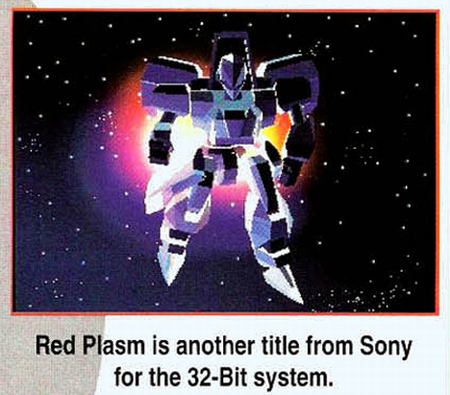
The first involves this shot of Red Plasm, a game apparently never released. It’s described as a first-party Sony creation, and its only other mention comes from the European mag Console Plus, which ran the same screenshot with an equally vague description.
The most likely explanation is that Red Plasm, or Red Plasma, is a very early version of Omega Boost, Sony’s space-bot shooter from 1999. Did it really wait in the wings for all those years while Polyphony Digital made Motor Toon and Gran Turismo? Perhaps. Omega Boost always seemed like someone’s backburner project, greenlit only after Gran Turismo turned its creators into a big wheel within Sony.
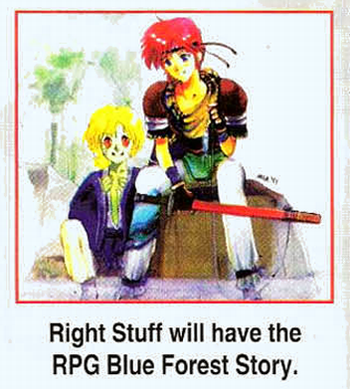
The other mystery? This shot. It’s allegedly from Right Stuff’s Blue Forest Story, an RPG released on the 3DO and PlayStation. In testament to how we often ignore untranslated RPGs, it's best known for having nudity in the 3DO version’s opening credits. I’ve owned and played Blue Forest Story, and I’m pretty sure that the above art isn’t from the game.
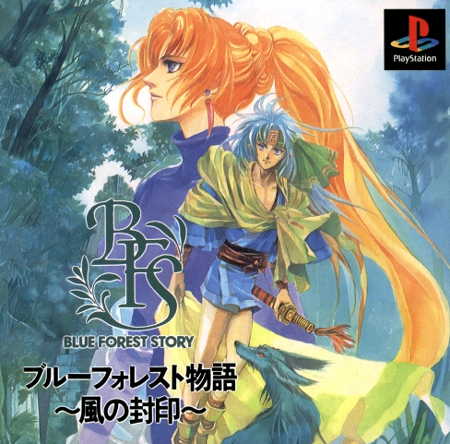
For one thing, the artwork looks nothing like the illustrations or in-game portraits for Blue Forest Story (above), which I don’t believe features a red-haired kid or a cheerful tow-headed zombie robot, unfortunately. It could be early artwork, or perhaps it’s from the tabletop RPGs that apparently inspired the Blue Forest Story game, though it’s a strange contrast to everything else I’ve seen about it. Yes, it’s a small mystery, but it gives me another chance to talk about Right Stuff.
6. EQUINOX IS A WELL OF DESPAIR
BloodStorm's siren song aside, the most memorable ad in this issue is Sony’s multi-pager for Equinox. It’s a Super NES game that will ruin your life.
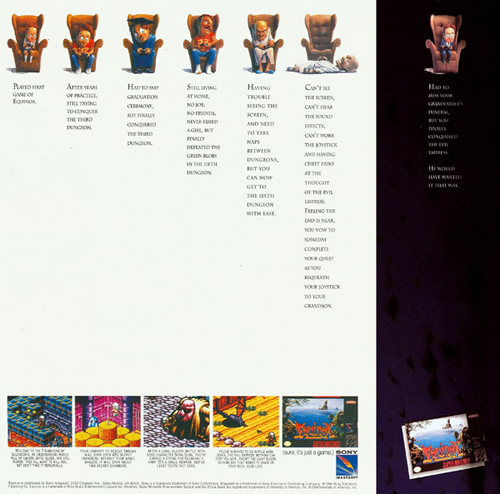
Equinox, a sequel to the NES action-puzzler Solstice, is decidedly harmless, but the magazine spot is a morbid cartoon mockery of a man so consumed by the game that it haunts him all his days and bars him from any meaningful pursuits. But it’s not all despairing; on the next page we see his grandson finally finishing his life's work.
7. DYNAMITE HEADDY’S CRAP
I understand why Dynamite Headdy didn’t stand out in the crowded world of Sega Genesis games from 1994. At a glance it looks as disposable an action game as Socket or Izzy’s Quest for the Olympic Rings. Delve within, however, and you’ll find a side-scroller with the inventive design that made Treasure a favorite developer in many parts. Headdy is a neckless marionette who gains new powers by modifying his floating noggin, and EGM2’s preview ran down a few of his abilities, including Hammer, Vacuum, and Crap.
Yes, Crap.
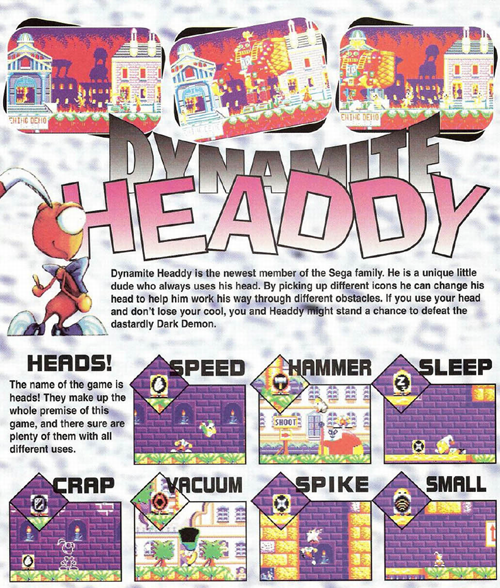
I’m mystified. The English Instruction manual calls this power-up “Empty Head,” and it renders Headdy invincible for a while. It could be some mistranslation, perhaps stemming from synonyms for empty-headed states. Or it could just be some filler text than an EGM2 designer left there, inadvertently telling children that Headdy has the ability to either gamble at a casino or simply take a shit right there in the middle of pastel toyland.
And that’s EGM2’s opening salvo. I didn’t subscribe, but I read this issue to rags and carved out the BloodStorm ad so I could enter the contest. I didn’t get anything, and to this day I wonder how different my life would be if I’d won the grand prize and had to drag around a BloodStorm arcade machine every time I moved.
Well, of course I’d never sell it.

You say you got that Mirage’s weapon is named “Anigav” but did you also noticed that she came from the desert region of Obsel? Man the 90s were something else…
ReplyDelete